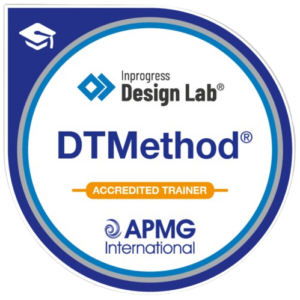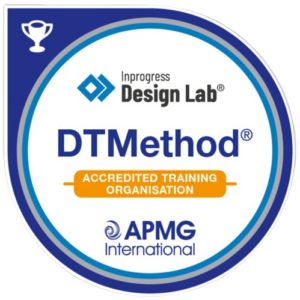Twenty Tools, Three Phases, One Goal: DTMethod's Blueprint for Breakthrough Innovation
DTMethod® (Design Thinking Methodology)
Explore the ways in which DTMethod's human-centric approach may revolutionize creativity and problem-solving inside your organization. Teams need the resources and knowledge to overcome difficult problems and have a positive impact.
DTModel: Repeatable Process
The DTModel assists teams in aligning with customer objectives and organizational goals by guiding them through a systematic and scalable three-phase process: Exploration, Creativity, and Construction.
DTTools: Practical Application
You can learn a lot about your users by using the DTTools toolkit. These tools help turn ideas into needs that can be put into action. This lets you make smart decisions based on real user data.
DTMethod Empowers Organizations

The Art and Science of Innovation DTMethod's Systematic Approach to Creative Solutions
DTMethod is an APMG-accredited framework that transforms Design Thinking into a systematic yet adaptable enterprise-ready methodology. The goals are simple: Create great products, solve big problems, develop excellent service, and change people's lives!
Built on three integrated pillars, DTMethod distills innovations to their essence - three powerful elements that work:
First, we use the model. DTModel orchestrates the journey of discovery through three strategic phases.
Then we have the tools. Not 20 random tools, but twenty carefully selected instruments that feel like they were always meant to work together. Each one is there for a reason. Each one matters.
Finally, it's not just about the tools - DTMethod supports a culture of innovation. Clear roles. Clear rules. Because great innovation isn't random - it's intentional.
It all works together. DTMethod represents a practical, scalable, and sustainable approach to Design Thinking that allows you to focus on making an impact!
Organizational Benefit
Strategic, Customer, and Business Benefits
Strategic Benefits:
• Transform Customer Experience: Build deep customer loyalty by solving real problems that matter
• De-Risk Innovation: Test and validate solutions before major investment - saving time and money
• Drive Market Leadership: Stay ahead by consistently delivering what customers actually want, not what we think they need
Tactical Benefits:
• Cut Development Waste: Reduce expensive late-stage changes by getting customer input early
• Make Better Decisions: Replace gut feelings with real customer data and feedback
• Speed Up Delivery: Move from concept to market-ready solutions faster and with more confidence
Operational Benefits:
• Remove Friction Points: Fix customer pain points before they hurt your business
• Create Flow: Get teams collaborating smoothly instead of working in silos
• Build Momentum: Turn customer-focused innovation into a repeatable process
Professional Benefits:
• Develop Future Leaders: Master skills that drive modern business success
• Solve Real Problems: Learn proven tools for tackling complex challenges
• Build Better Teams: Create a culture where innovation and collaboration thrive
Course Content
- Design Thinking Basics and Double Diamond
- Design Thinking Relationship to Project Management
- Innovation and Problem-solving Architecture - vDTModel: composed of 3 phases
- Practical Toolkit - DTTools: 20 practical tools
- Governance & Implementation - DTRules&Roles, that is, the rules (and roles) to follow applying DTMethod
Content Delivery
We adapt to your team's needs with two learning experiences: in-person workshops at your location or virtual sessions that bring our expertise directly to your team. Our goal is to maximize your team's time, value, and productiity.
Course Duration
The typical schedule is for 3 consecutive days, but we could also run 5 half days for virtual sessions to help meet business needs. This flexibility allows for a more customized approach to training that can accommodate varying schedules and time constraints.
Who should attend
Ideal for professionals who:
• Agile Professionals
• Business Analysts
• Business Unit Leaders
• Change Management Specialists
• Customer Experience Managers
• Department Managers
• Digital Transformation Leaders
• Directors
• Experience Design Leaders
• Facilitators
• Process Improvement Team Members
• Scrum Masters
• Service Delivery Managers
• Service Designers
• Team Leaders
• Technical Leads
This program equips decision-makers and practitioners across all levels with proven tools to drive innovation and prolbem-solving, enhance customer value, and deliver measurable business results.
What are the course fees?
DTMethod Foundation Training: USD $1,350
This 3-day comprehensive program covers DTMethod principles and practices, with your APMG certification exam included in the price.
Upon completion, you'll take the official certification exam to demonstrate your mastery and earn internationally recognized credentials in DTMethod.
Discounts for groups of 3 or more available from the same organization.
DTMethod® (Design Thinking Methodology) Live Online Schedules
| Course | Begin Date | End Date |
|---|---|---|
| DTMethod® Foundation | September 29,205 | October 1, 2025 |
| DTMethod® Foundation | November 3, 2025 | November 5, 2025 |
| DTMethod® Foundation | December 15, 2025 | December 17, 2025 |
- Format and investement: Live Online DTMethod® Foundation is $1,375.
- Duration: 3 days
- Schedule: 8:00am-5:00pm Central Standard Time (CST)
- Included: The package includes training material, tools, exam support, and the official certification exam provided by APMG.
- Discounts: Discounts on the combination of Change Foundation and Change Practitioner are available. Group discounts are available for three or more from the same organization.
- Contact us for live, in-person proposals or custom pricing and schedule options.
Real Impact from Real Training
DTMethod® Credentials

APMG International has accredited Topstone Consulting's trainers. This indicates that our trainers are subject to ongoing evaluations and that they are able to meet the quality standards set by APMG.
FAQs
This is the text area for this paragraph. To change it, simply click and start typing.
What is Design Thinking?
Design Thinking is a human-centered approach to problem-solving and innovation that prioritizes understanding and addressing the unique needs of individuals. It's a methodology that uses creative activities to foster collaboration and solve problems.
How does design thinking help with complex challenges?
Design Thinking is particularly helpful for "wicked problems," which are ill-defined and complex challenges where both the problem and the solution are unknown at the beginning. A significant part of solving these problems is the act of defining the problem itself. These problems also often involve significant risk as they require stepping outside an organization's comfort zone.
The human-centered, iterative, and exploratory nature of Design Thinking makes it well-suited for such challenges. Design Thinking provides a structured yet flexible approach to navigate ambiguity and uncover effective solutions for these tricky, high-risk situations.
Who is Design Thinking for?
Design Thinking is fundamentally a human-centered methodology, meaning it is intended for anyone aiming to solve problems by deeply understanding and addressing the needs of people. Its user-centric focus makes it broadly applicable across industries and roles.
Some Examples include:
Product Designers and Developers: To create solutions that are desirable, feasible, and viable by focusing on real user needs.
Business Leaders and Entrepreneurs: To innovate products, services, or business models that resonate with target customers and stand out in the market.
Marketing and Sales Teams: To better define and understand target audiences, create personas, and tailor campaigns for maximum impact.
Service Providers: To improve customer experiences by mapping customer journeys and identifying pain points.
Nonprofits and Social Innovators: To design programs and interventions that effectively address community needs.
Educators and Students: To foster creative problem-solving and collaboration in learning environments.
How can small to medium organizations use Design Thinking? Title or Question
Improving Customer Experience:
Redesign service touchpoints, websites, or physical spaces to better meet customer needs and increase satisfaction.
Developing New or Enhanced Products/Services:
Create innovative offerings or refine existing ones based on genuine user feedback and market gaps.
Optimizing Internal Processes:
Streamline workflows, communication, or collaboration within teams to boost efficiency and morale.
Boosting Employee Engagement and Culture:
Involve employees in co-creating solutions, improving workplace culture, and fostering innovation.
Recruitment and Onboarding:
Innovate hiring and onboarding processes to attract and retain talent.
What is AI's impact on design thinking?
Due to AI's ability to augment rather than replace the design process, design thinking abilities are becoming increasingly valuable. The design thinking process is enhanced by AI, which helps teams tackle complicated challenges more quickly and accurately through better data analysis, pattern recognition, and predictive capabilities.
AI excels at theses tasks but lacks the inherently human ability to think abstractly or understand emotional nuances. This creates opportunities for human-AI collaboration where AI handles data-heavy tasks while humans focus on creative problem-solving and empathetic understanding.



